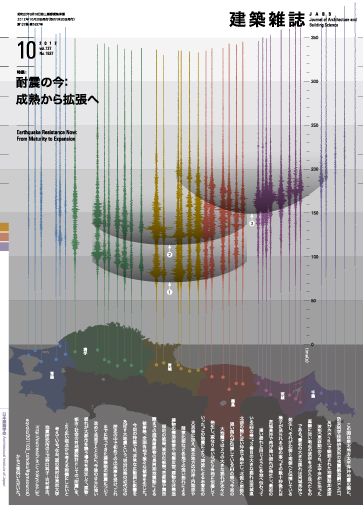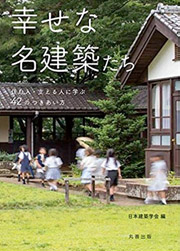本文PDFの閲覧につきましては、こちらでご確認ください。

2012-10月号 OCTOBER
特集= 耐震の今─成熟から拡張へ
Earthquake-Resistance Now─ From Maturity to Expansion
特集前言 社会的課題としての耐震―進路を導く現状認識を
明治以降、建築構造物の近代的な耐震技術・制度は、常に実際の被害事例を教訓として発達してきた。1978年の宮城県沖地震を契機として1981年に施行されたいわゆる新耐震基準後も、1995年の兵庫県南部地震を受けて評価と改正が行われ、免震・制震などの新技術の導入も進んでいた。こうして「成熟」を迎えつつあった「耐震」に対して、2011年の東北地方太平洋沖地震はどのようなインパクトをもたらしたのか。
発災直後に広く聞かれたのは、新耐震以後の建物の主体構造には大きな問題はないが、津波被害、非構造部材の被害、液状化といった課題が浮上した、という状況認識だった。同時に、建物・都市の機能維持・回復可能性といった問題が指摘された。高度にネットワーク化された社会・経済活動のもとでは、耐震に求められるのは人命保護だけではない。東北地方太平洋沖地震はまた、今後の巨大地震の想定にも影響を与え、実現すべき耐震の目標像を押し上げ、押し広げつつあるように見える。そこには今後の社会構造や都市の変化、不動産の問題などもかかわらざるをえない。明治以降、今ほど耐震の「拡張」が求められている時代はないのかもしれない。
もちろん、耐震はもとより技術的問題であるのみならず社会的・経済的・政治的問題でもあった。しかし、20世紀における成熟の過程と特質を問い直しつつ、今後の社会・自然環境のなかで、より広い視野での総合的な議論と、そのための柔軟なリテラシーがいよいよ不可欠になってきているのは事実だろう。
東北地方太平洋沖地震は、地震動および実際の建物の耐震性能を検証しうる多くのデータを与えてくれた。発災から1年余が経過するなかで、それらが多角的に分析され、技術的・制度的な議論が展開されつつある。発災直後の印象とは異なる認識や視角も見出されているだろう。
千年に一度と言われる超巨大地震だが、建築物の振動という観点からはどのような地震であったのか。そして、今専門家たちはどのような視野と視座から、どこに問題を見定め、今後の方向性をどう探りつつあるのか。
冒頭には「年表:耐震のあゆみ」(編集委員会作成)を置き、日本における主な地震と耐震の技術・制度的展開との関係を照応できるようにした。
巻頭座談会では、塩原等・西山功・目黒公郎・源栄正人の4氏に、今日の「耐震」が東北地方太平洋沖地震に対して有効に対応しえたのかを総合的に論じていただいた。国の技術基準や学会基規準の有効性、学問ディシプリンの問題、脆弱ストックの問題、マイクロゾーニングの重要性などの幅広い論点が示されている。
第1部の各論的な検証がこれに続く。観測された地震動の特性に関する記事の後、鉄筋コンクリート造建物、鉄骨造建物、免震・制震建物、木造建物といった構造種別、基礎構造と液状化対策といった技術要素・部位別、さらにこれまでの耐震改修の進捗、耐震基準などの制度面を個別に取り上げて、それぞれに現状の評価と特徴的な課題、今後の展望などを書いていただいている。加えて、2011年12月に耐震技術者を対象に実施されたアンケートの結果から、専門家が東北地方太平洋沖地震をどう認識したのかを概説していただいた。
第2部では、想定される東海・東南海・南海地震あるいは首都直下地震を踏まえつつ、今後の耐震の課題をどう設定するかが問われる。超高層建物に求められる対応、高レベル地震動に対する設計条件の問題、非構造部材の落下事故解消、昇降機システムの耐震安全性、家具・什器・設備の耐震化、既存ストックの耐震補強についての議論に続けて、耐震を都市・社会の広範な領域に接続する問題としてとらえ、社会システムとして実現する考え方について論じていただいた。
巻末座談会では、池田浩敬・佐土原聡・深澤義和・福和伸夫の4氏を招き、環境工学や都市計画の立場も交えながら今後の耐震に期待されることを広く多角的に討論していただいている。
会誌編集委員会
本号編集担当:田村和夫(千葉工業大学)・加藤研一(小堀鐸二研究所)・樫本信隆(日建設計)
[目次]
| 000 | 連載 再建への意志:図面のなかの都市復興 ベイルート復興計画(1933年/1992年)/松原康介 |
| 002 | 連載 東日本大震災|連続ルポ1|動き出す被災地 東京湾岸液状化被災地、浦安の現状報告─次なる首都直下型をどう受け止めるか/中野恒明 |
| 004 | 連載 東日本大震災|連続ルポ2|仮すまいの姿 外国人妻と地域社会/山田直子 |
特集 耐震の今:成熟から拡張へ
| 006 | 特集前言 社会的課題としての耐震─進路を導く現状認識を |
| 008 | 耐震のあゆみ/会誌編集委員会 |
| 010 | 巻頭座談会 巨大地震に耐震は機能したか 塩原等 × 西山功 × 目黒公郎 × 源栄正人 |
第1部 耐震の今と3.11
| 014 | 地震・地震動はどこまでわかっていたか/大野晋 |
| 016 | 鉄筋コンクリート建物の地震被害と耐震性能の現状/壁谷澤寿海 |
| 018 | 鉄骨造建物の耐震安全性の現状/緑川光正 |
| 019 | 免震・制振建築物の安全性の現状/齊藤大樹 |
| 020 | 木造建築の耐震性/大橋好光 |
| 022 | 基礎構造の耐震・液状化対策/中井正一 |
| 023 | 耐震改修促進法に基づく取組みの現状/前田亮 |
| 024 | 耐震基準と3.11/福山洋 |
| 025 | コラム 計測震度と建物被害/境有紀 |
| 026 | アンケートから見た耐震技術者の意識:3.11をどうとらえたか/小林正人 + 永野正行 |
| 028 | コラム グローバリゼーション時代の構造エンジニア/金田充弘 |
第2部 これからの耐震
| 029 | 超高層建物に求められる耐震性能/北村春幸 |
| 031 | 高レベル地震動と耐震設計/林康裕 |
| 032 | 非構造部材の落下事故の解消に向けて─単なる耐震から真の安全安心へ/川口健一 |
| 034 | 昇降機システムの耐震安全性/藤田聡 |
| 035 | 建物内の耐震化に向けて(家具・什器、設備)/金子美香 |
| 036 | 耐震補強の有効性と今後/田中礼治 |
| 038 | 都市・社会における「耐震」/廣井悠 |
| 040 | 巻末座談会 建築の耐震に期待すること 池田浩敬 × 佐土原聡 × 深澤義和 × 福和伸夫 |
| 045 | 編集後記 田村和夫 + 加藤研一 + 樫本信隆 |
| 045 | 次号予告 2012年11月号|特集:トーキョー・アーバニズム ─駆動力、リスク、ライフスケープ |
| 046 | 特集を読んで 2012年8月号|特集:広島[ヒロシマ]・長崎[ナガサキ] 甦る閃光とヒロシマ・ナガサキへの外部からの視点/秋本福雄 生活再建の場としてのヒロシマ・ナガサキと「公」の問題/布川弘 |
| 047 | 連載 建築の争点 環境共生─共に生きるとは/林昭男 |
| 048 | 連載 なぜ私は建築を選んだか 一番身近な仕事に/小西泰孝 |
| 049 | 連載 Architect Politician ニューアーバニズムの旗手となった名物市長─ジョン・ノーキスト/佐々木宏幸 |
| 050 | 連載 地域いろいろ・多様な日本 大地の芸術祭の里を巡って/渡辺斉 |
Preface to the Special Issue: Earthquake Resistance As a Social Issue
- Understanding the Status Quo That Leads the Way
After Meiji, the modern techniques and systems of earthquake resistance in building structures have always improved by taking lessons from actual cases of damage. After enforcement of the new seismic regulations in 1981, which were motivated by the 1978 Miyagi-kenoki Earthquake, further evaluation and revision followed based on the 1995 Hyougoken-Nanbu Earthquake, and the innovation of new techniques such as base isolation and vibration control have since progressed. So, vis-a-vis the earthquake resistance that had just come to maturity, what impact did the 2011 Off the Pacific Coast of Tohoku Earthquake bring?
The realization of the condition widely heard about just after the disaster was that although there were no major problems with buildings' main structures, thanks to the new seismic regulations, other issues did come to the surface: tsunami damage, damage to nonstructural elements, liquefaction, and so on. At the same time, problems such as buildings' and cities' functional maintenance and the possibility of their recovery were pointed out. Under the highly networked social and economic activity, life protection is not the only thing required for earthquake resistance. It seems that the Off the Pacific Coast of Tohoku Earthquake is also influencing assumptions about catastrophic earthquakes hereafter and is raising and stretching the image of earthquake resistance's goal, which should be achieved. Hence, changes in social structure and cities and real estate issues cannot avoid being involved. Since Meiji, probably no other age has asked for such an expansion in earthquake resistance.
Of course, earthquake resistance was not only a technical issue but also a social, economic, and political issue. But while asking anew about the process and characteristics of maturity in the twentieth century, it must be true that comprehensive arguments based on wider horizons and on the flexible literacy for those arguments are becoming increasingly indispensable in a future social and natural environment.
The Off the Pacific Coast of Tohoku Earthquake gave us lots of data with which to inspect earthquake ground motion and actual buildings' seismic performance. During the year and more since the disaster, that data has been diversely analyzed, and both technical and institutional arguments are developing. Realizations and points of view, whose impression is different from that right after the disaster, may have been found.
Although it is said to be a super catastrophic earthquake that occurs only once every thousand years, what kind of earthquake was it in view of building vibration? And now, in terms of standpoint and angle, where do the experts focus to confirm problems, and how are they seeking the future course?
The opening page contains "Chronology - The Record of Earthquake Resistance" (by the Editorial Board) to clearly show the correspondence between major earthquakes in Japan and technical and institutional developments in earthquake resistance.
In the opening conversation Hitoshi Shiohara, Isao Nishiyama, Kimiro Meguro, and Masato Motosaka comprehensively discuss how effectively today's earthquake resistance could have met the Off the Pacific Coast of Tohoku Earthquake. Some widely disputed points are shown: the efficacy of national technical standards and of institutional standards and criteria, the issue of academic discipline, the issue of weak stock, the importance of micro-zoning, and so on.
Theoretical verifications follow in part 1. After an article about the characteristics of the observed earthquake ground motion, writers, while picking up individually the kinds of structures (reinforced concrete buildings, steel building structures, base-isolated and response-controlled buildings, wooden buildings, and so on), the kinds of technical factors and regions (such as foundations and measures against liquefaction), and, moreover, the kinds of systems (the progress until now in seismic rehabilitation, seismic regulations, and so on), write an evaluation of the status quo, the characteristic issues, and the outlook hereafter for each kind. In addition, based on the results of a December 2011 questionnaire for earthquake-resistance engineers, they outline how experts perceived the Off the Pacific Coast of Tohoku Earthquake.
In part 2, it is asked how future seismic issues should be set up on the basis of assumed Tokai, Tonankai, and Nankai earthquakes, or a near-field earthquake in a metropolitan area. Following several arguments - about the management required for skyscrapers; the issues of design conditions for high-level ground motion; the elimination of falling accidents involving nonstructural elements; the seismic safety of lift systems; the improving seismic safety of furniture, utensils, and equipment; and the seismic strengthening of existent stocks - the idea of getting earthquake resistance as an issue connected to the extensive fields of cities and societies, and of realizing it as a social system is discussed.
For the closing conversation Hirotaka Ikeda, Satoru Sadohara, Yoshikazu Fukasawa, and Nobuo Fukuwa were invited to widely and diversely discuss what is expected of future earthquake resistance, including the positions of environmental engineering and city planning.
Editorial Board
This issue has been edited by Kazuo Tamura (Chiba Institute of Technology), Kenichi Kato (KOBORI RESEARCH COMPLEX INC.), and Nobutaka Kashimoto (Nikken Sekkei Ltd.)
[contents]
| 000 | [Series] The Resolve to Rebuilding: City Reconstruction in Blueprint Reconstruction Plans for Beirut (1933/1992) / Kosuke Matsubara |
| 002 | [Series] Great East Japan Earthquake Serial Report 1 Devastated Areas Have Just Started to Stir Report on the Status Quo in Urayasu, a Liquefaction-Disaster Tokyo Bay Area ─How to Take the Next Near-Field Earthquake in a Metropolitan Area / Tsuneaki Nakano |
| 004 | [Series] Great East Japan Earthquake Serial Report 2 Life in Temporary Housing Wives from Abroad in Local Communities / Naoko Yamada |
Special Feature
Earthquake Resistance Now: From Maturity to Expansion
| 006 | [Preface to the Special Issue] Earthquake Resistance As a Social Issue ─Understanding the Status Quo That Leads the Way |
| 008 | The Record of Earthquake Resistance / Editorial Board |
| 010 | [Discussion] Did Earthquake Resistance Work for the Catastrophic Earthquake? Hitoshi Shiohara × Isao Nishiyama × Kimiro Meguro × Masato Motosaka |
Part1 Earthquake Resistance Now and On 3.11
| 014 | How Well Had Earthquakes and Earthquake Ground Motion Been Understood? / Susumu Ohno |
| 016 | Recent Earthquake Damages and Seismic Performance Levels of Reinforced Concrete Buildings / Toshimi Kabeyasawa |
| 018 | Seismic Safety of Existing Steel Building Structures / Mitsumasa Midorikawa |
| 019 | The Recent Safety of Buildings with Base Isolation and Vibration Control / Taiki Saito |
| 020 | The Seismic Performance of Wooden Buildings / Yoshimitsu Ohashi |
| 022 | Seismic Design of Foundations and Measures against Liquefaction / Shoichi Nakai |
| 023 | Recent Efforts Based on the Act for Promotion of Renovation for Earthquake-Resistant Structures / Ryo Maeta |
| 024 | Seismic Regulations from the View of 3.11 Disasters / Hiroshi Fukuyama |
| 025 | Column Instrumental Seismic Intensity and Building Damage / Yuki Sakai |
| 026 | Awareness of Experts on Earthquake Engineering from a Questionnaire Investigation: How Does the 3.11 Disaster Impact Them? / Masahito Kobayashi + Masayuki Nagano |
| 028 | Column Structural Engineers in the Age of Globalization / Mitsuhiro Kanada |
Part2 Future Earthquake Resistance
| 029 | Seismic Performance Levels Required for Skyscrapers / Haruyuki Kitamura |
| 031 | High-level Ground Motions and Seismic Design / Yasuhiro Hayashi |
| 032 | Toward the Elimination of Falling Accidents Involving Nonstructural Elements ─From Mere Earthquake Resistance to Genuine Safety and Security / Kenichi Kawaguchi |
| 034 | Seismic Safety of Elevator and Escalator Systems / Satoshi Fujita |
| 035 | Improvement of Indoor Seismic Safety of Buildings (Furniture, Building Equipment) / Mika Kaneko |
| 036 | The Efficacy of Seismic Strengthening and Hereafter / Reiji Tanaka |
| 038 | Earthquake Resistance in Cities and Societies / U Hiroi |
| 040 | [Discussion] Expectations from Architectural Earthquake Resistance / Hirotaka Ikeda × Satoru Sadohara × Yoshikazu Fukasawa × Nobuo Fukuwa |
| 045 | [Editor's Postscripts] Kazuo Tamura + Kenichi Kato + Nobutaka Kashimoto |
| 045 | [Previews of Coming Issues] 2012, November: Tokyo Urbanism ─Driving Forces, Risks, and Lifescape |
| 046 | [Reviews of Previous Issue] 2012, August: Hiroshima and Nagasaki: City, Peace and Architects Recalling the Flash, and the Outside View of Hiroshima and Nagasaki / Fukuo Akimoto Hiroshima and Nagasaki as Sites of Life-Reconstruction, and Issues of "the Public" / Hiroshi Nunokawa |
| 047 | [Series] Issues in Architecture Environmental Symbiosis─What Living Together Is / Akio Hayashi |
| 048 | [Series] Why and How I Chose Architecture A Job in My Own Backyard / Yasutaka Konishi |
| 049 | [Series] Architect Politician John O. Norquist, a Popular Mayor who Became the CNU President / Hiroyuki Sasaki |
| 050 | [Series] Local Identities: Diverse Japan Walking Around Echigo-Tsumari Art Field / Hitoshi Watanabe |




 『幸せな名建築たち 住む人・支える人に学ぶ42のつきあい方』
『幸せな名建築たち 住む人・支える人に学ぶ42のつきあい方』





